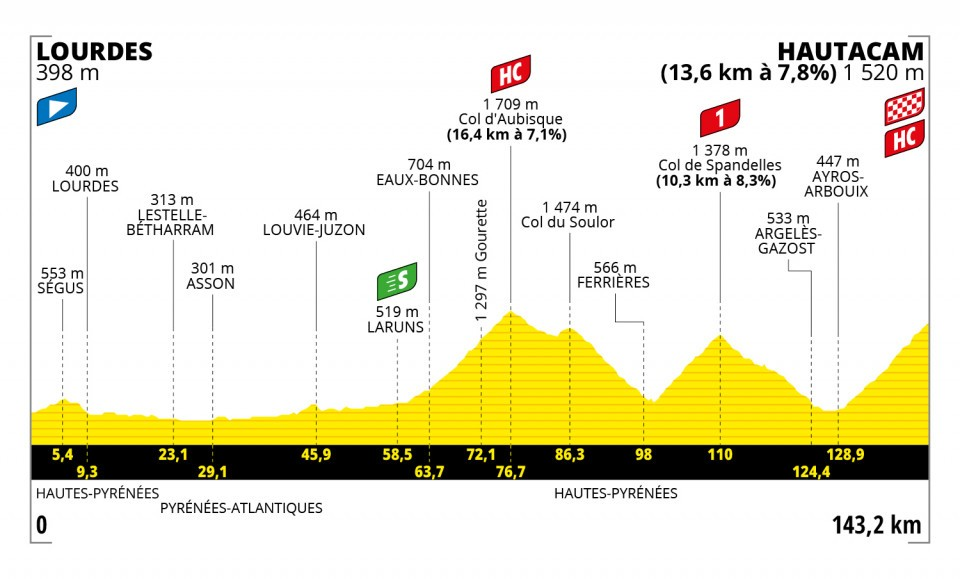The Seven Key Stages of the 2022 Tour de France
Here's our guide to the stages we think will make or break the yellow jersey contenders' chances of stepping onto the podium in Paris after 3 weeks of racing
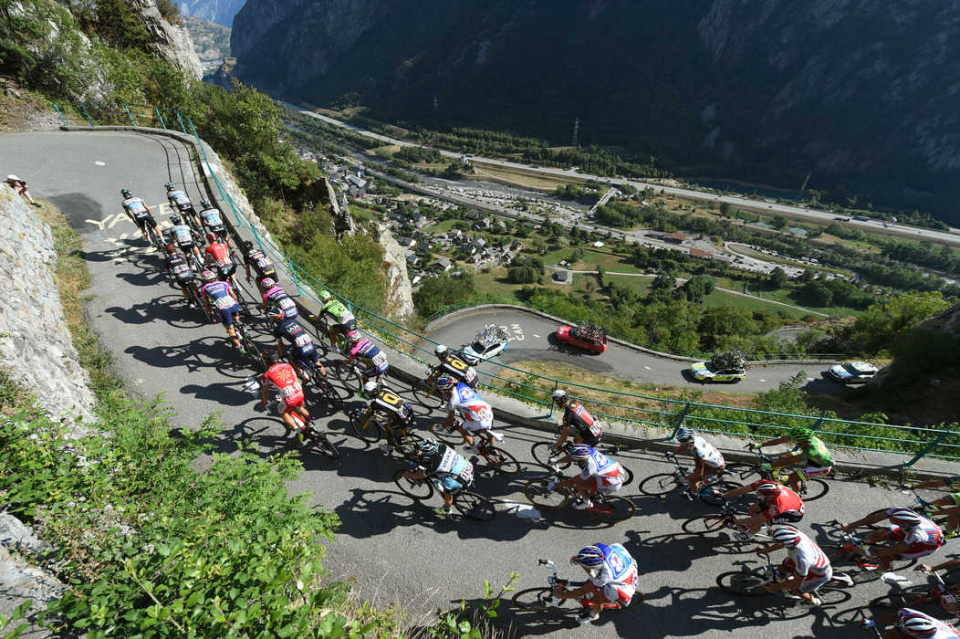
The 109th editon Tour de France, begins on Friday July 1st in Copenhagen, Denmark, and will end as usual in Paris on Sunday July 24th.
The 2022 Tour de France Grand Depart starts in Copenhagen, the gorgeous Scandinavian capital of in Denmark. An individual time trial kicks off the three weeks – so the GC competition will begin from the gun. Expect to see Tadej Pogacar and Primož Roglic putting in fierce fights these first days, against the time trial specialists like Ganna and Dennis.
The race moves swiftly to Northern France, for a little taste of the cobbles of Paris Roubaix, deep in the trenches of the Arenberg Forest. Whereas Paris Roubaix, the one day classic is fought by the harder, bigger riders, when it’s part of the Tour, the general classification battle lives on and our lightweight climbers will have to fight to stay in the race that day, on terrain foreign to many of their likings.
The first week is full of sprint stages, where we are likely to see Wout Van Aert and Mathieu Van Der Poel continue their rivalry for the green jersey (points classification.)
The race moves into the Alps in the second week. The Télégraphe and Galibier and a summit finish on Alpe d’Huez stand out as spectacular places to watch. For a lesser known summit, watch out for the decisive 2,413-metre Col du Granon on stage 11. As the general classification rolls on, the climbers will blossom here, and the Polka Dot (climbers) jersey competition will begin to be contested.
Will it be a year for the French riders for the Polka Dot Jersey? This jersey seems to hold a special place in the hearts of the French cycling fans, and it could be a showdown between Bardet vs. Barguil and Gaudu vs Martin.
The third week the race heads south west into the Pyrenees and the mountains come thick and fast. Stage 17, the peloton will take on the Col d’Aspin, the Hourquette d’Ancizan, and the Col d’Azet. Think that’s enough? Well, not for the race organisers. One more kick finishes the day on the climb to Peyragudes altiport. If that wasn’t enough, the next day brings the same intensity. The final mountain stage of the race takes on the legendary Hautacam. From the city of Lourdes, and with the Col d’Aubisque and and the Col de Spandelles between the final brutal climb, this is one of the last true days to win the Tour.
Stage 1 - July 1st | Copenhagen | 13.2 km
The Tour can neither be won in a 14km opening stage time trial, nor can it be lost. What it can be is a harbinger of potential - or lack thereof. What we’ll be looking to see is how the favourites fare against their own high standards. To be in with a chance of taking his first Tour de France victory, elder Slovenian Primoz Roglic probably needs to ride his best time trial ever!
We haven’t seen a lot of Tadej Pogacar since mid-spring, and none of him in a major stage race since Tirreno-Adriatico, but there is the reasonable fear that he may be even stronger than 12 months ago. Opening day will offer our first clue. As for the stage itself, Filippo Ganna will win it. And if he doesn’t, Wout van Aert probably will.
Summary: All GC contenders need good time trialling skills.
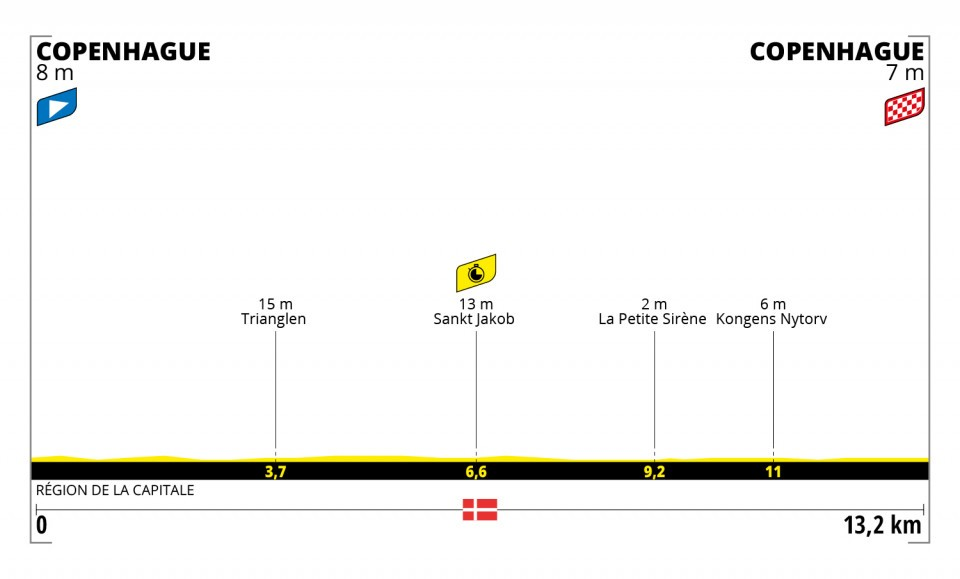
Stage 5 - July 6th | Lille – Arenberg Porte du Hainau | 153.7 km
Commeth the cobbles, 19.4km of the rough stuff is why Primoz Roglic and Jonas Vinegaard rode the GP Denain in March. The peloton needs to cover a total of eleven cobblestone sections on the 153.7-kilometre course from Lille to Arenberg Porte du Hainau. These sectors that add up to a total of 19.4 kilometres of toughest pavés – all to be found in the second half of the race – are not to be underestimated. For last year’s winner Tadej Pogacar this stage is a first and could also be an acid test, as he has never ridden on such a brutal cobblestones in a race.
Summary: Losing time on this stage could be a receipe for disaster, the narrow roads, potential for high winds, wet cobbles and mechanicals will make this a nervous stage.
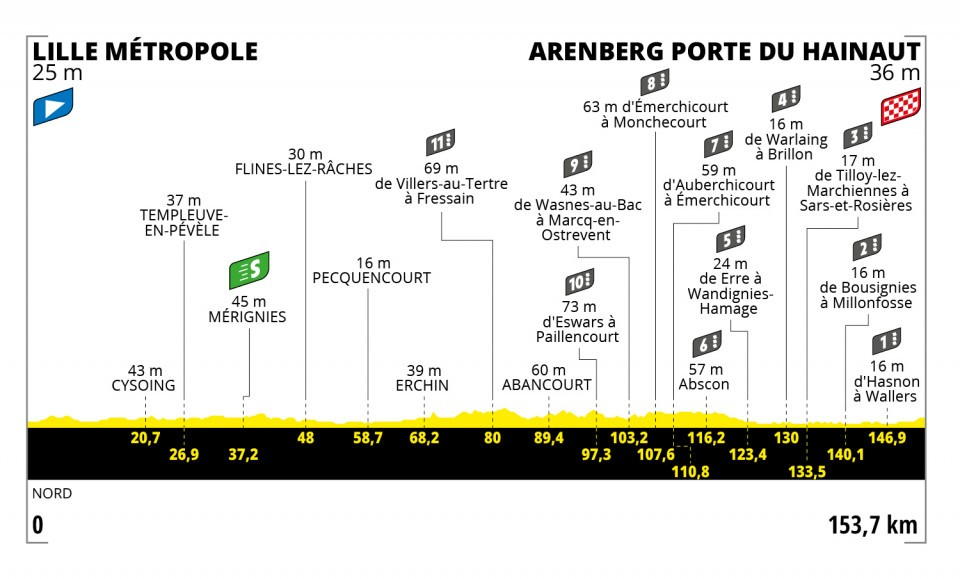
Stage 7 - July 8th | Tomblaine – La Super Planche des Belles Filles | 176.3 km
La Planche des Belles Filles became La Super Planche des Belles Filles by adding a steep 24 percent ramp to the already difficult climb in the Vosges.
The first mountain finish of this Tour de France will show who is still in the race for a top ranking at the end of the “Grand Boucle”. Maybe “Pogi” and “Rogla” will be in for an early duel on this climb – that may offer the latter a chance to take revenge.
Summary: The GC contenders will want to stamp their authority on the race early on.
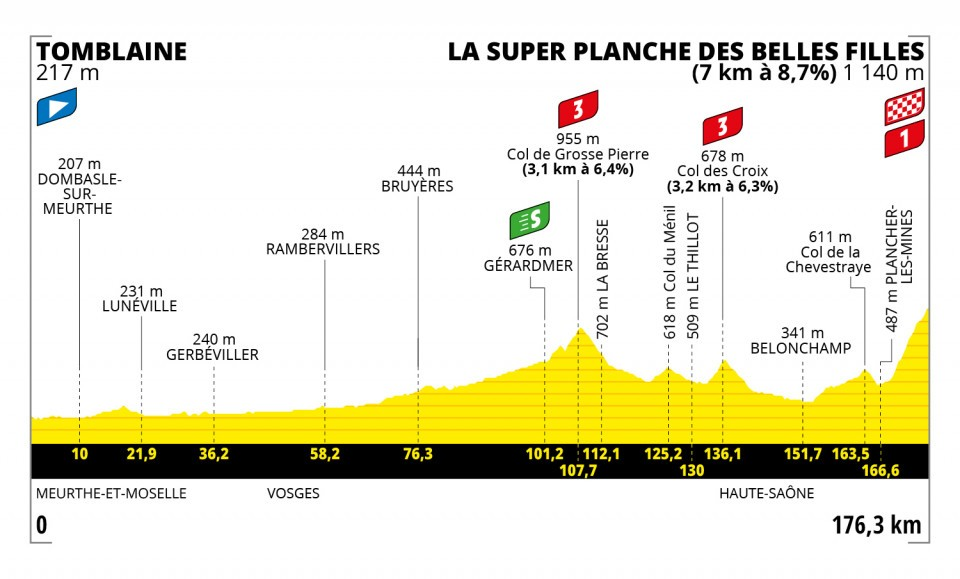
Stage 11 - July 13th | Albertville – Col du Granon | 151.7 km
The first day in the high mountains – and what a day it is. The stage is only 149 kilometres long and starts in the Olympic city of Albertville. It then heads in the direction of this year’s highest points via the Lacets de Montvernier: (Lacets means hairpins (think shoes laces). the Col du Galibier with its 2,642 metres, the highest point in 2022, and a souvenir of Henry Desgrange. Riders will climb it via the Col du Télégraphe – two passes that add up to 29.6 kilometres uphill all in all which are only interrupted by a short descent to Valloire. Via Col du Lautaret riders descend from the Galibier before they enter the difficult and final ascent to Col du Granon – a Hors Categorie climb like the Galibier. The 11.3 kilometres with an average gradient of 9.2 percent will very likely have an impact on the overall classification – maybe even a pre-decision will be made this early in the Tour.
Summary: A very tough day in the Alps, GC contenders cannot afford to have a bad day and will need to stay in contention for the final climb.
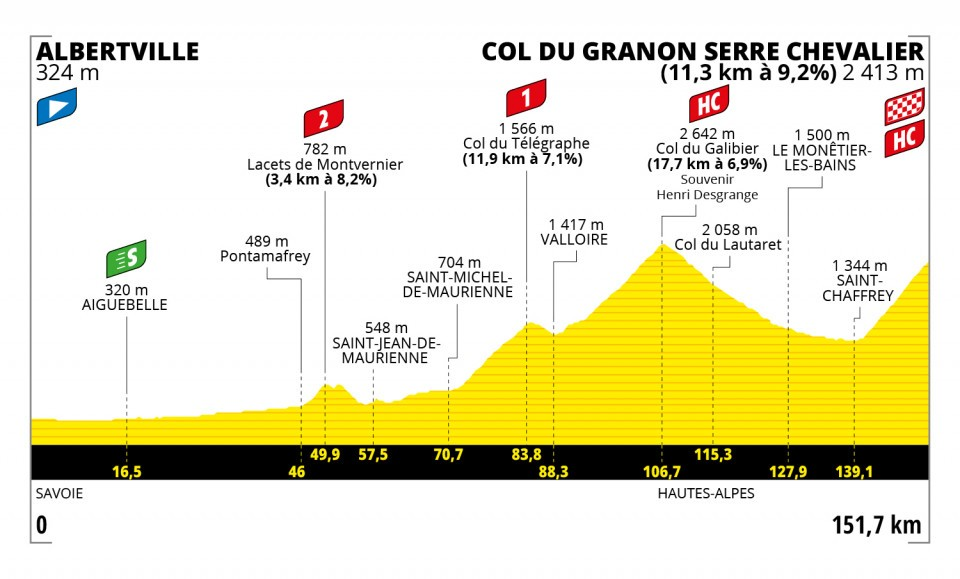
Stage 12 - July 14th | Briancon – Alpe d’Huez | 165.1 km
Riders will experience a déjà vu on that day, as they will need to climb the mountain they were descending from yesterday. The ascent starts in Briancon and leads over the Col du Lautaret up to the Col du Galibier. Not an easy start to this day, which is a special one for the Grande Nation. July 14th is a French bank holiday (Bastille Day) and loaded with expectations. Of course, they will want a French rider to win today!
From the Galibier, the course leads over the Telegraphe down into the Maurienne valley. From Saint-Jean-de-Maurienne an ascent of almost 30 kilometres and an average of 5.2 percent leads the riders to the Col de la Croix de Fer, a Hors Categorie climb, like Galibier, and also to that day’s final climb: the mythical 21 hairpin bends up to Alpe d’Huez. The serpentines will be lined with tens of thousands of spectators and will make for the sporting fireworks of this holiday on the one hand and very likely tear large gaps between the groups of riders on the other.
Summary: Back-to-back brutal days in the high mountains with a finish up the legendary brutal climb of Alpe d'Huez. Any GC contender cannot afford to have a bad day, or it's game over.
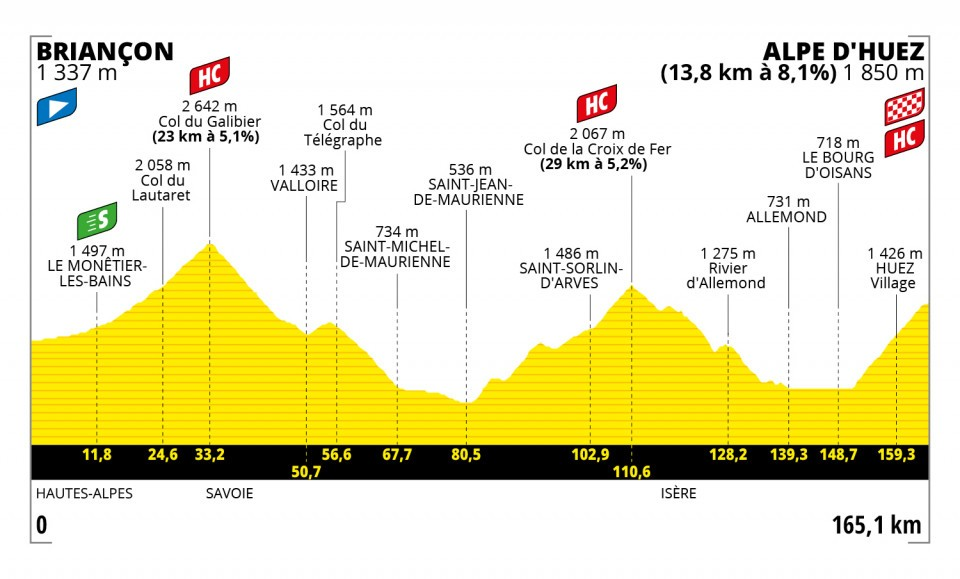
Stage 17- July 20th | Saint Gaudens to Peyragudes | 130 km
Four climbs introduce the Pyrenees with a bang as the peloton hits the first of the two final mountain stages of the race. The finish on Peyragudes comes after ascents up the Col d'Aspin, the Hourquette d'Ancizan and the Col de Val Louron-Azet.
The scenario is as sumptuous for the spectators as it is demanding for the leaders, who will have to defend their positions. After crossing the Col d’Aspin and the Hourquette d’Ancizan, attacks could come as early as the climb to the Col d’Azet. And in the final, even the best climbers might flounder when tackling the steep gradients towards the Peyragudes altiport... the third runway to success in the 2022 Tour!
Summary: A brutal stage in the Pyrenees where the GC contenders will have to be on their guard all day.
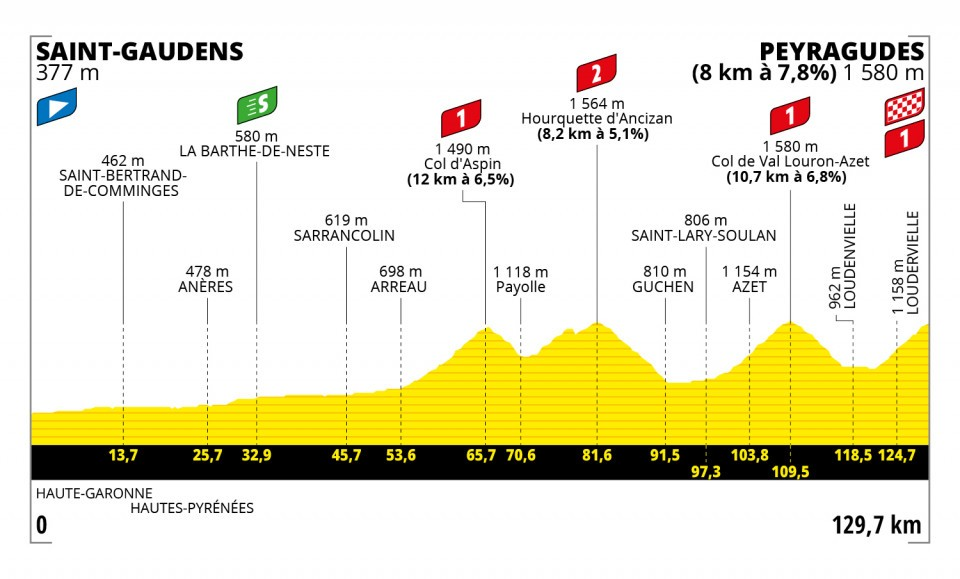
Stage 18 - July 21st | Lourdes – Hautacam | 143.2 km
The peloton needs to conquer two Hors Categorie climbs and one 1st category climb in just 80 kilometres. Starting from the pilgrimage town of Lourdes the stage climbs the over the Col d’Aubisque (16.4 kilometres with an average gradient of 7.1 percent), then over the Col de Spandelles (10.3 kilometres with an average gradient of 8.3 percent), and to the final climb to Hautacam. Memories of dramas and victories starringe protagonists like Bjarne Riis (1996), Lance Armstrong and Jan Ullrich (both 2003) come to mind. What remained, however, is an average gradient of 7.8 percent over 13.6 kilometres and the chance for the best riders to gain minutes on their opponents.
Summary: Another brutal day stage in the Pyrenees, GC contenders have their final opportunity to gain time on the slopes of Hautacam.
